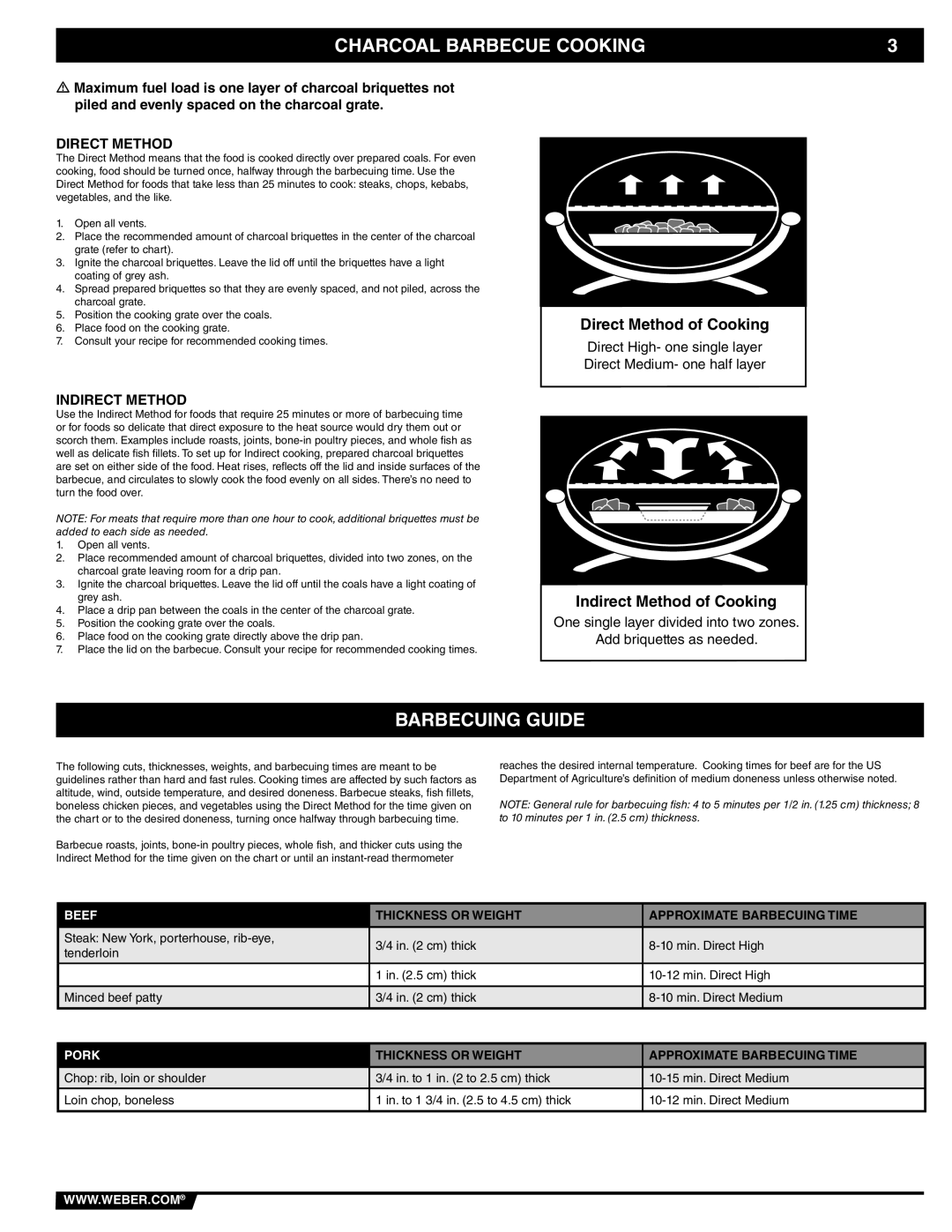
CHARCOAL BARBECUE COOKING | 3 |
|
|
Maximum fuel load is one layer of charcoal briquettes not piled and evenly spaced on the charcoal grate.
DIRECT METHOD
The Direct Method means that the food is cooked directly over prepared coals. For even cooking, food should be turned once, halfway through the barbecuing time. Use the Direct Method for foods that take less than 25 minutes to cook: steaks, chops, kebabs, vegetables, and the like.
1.Open all vents.
2.Place the recommended amount of charcoal briquettes in the center of the charcoal grate (refer to chart).
3.Ignite the charcoal briquettes. Leave the lid off until the briquettes have a light coating of grey ash.
4.Spread prepared briquettes so that they are evenly spaced, and not piled, across the charcoal grate.
5.Position the cooking grate over the coals.
6.Place food on the cooking grate.
7.Consult your recipe for recommended cooking times.
Direct Method of Cooking
Direct High- one single layer Direct Medium- one half layer
INDIRECT METHOD
Use the Indirect Method for foods that require 25 minutes or more of barbecuing time or for foods so delicate that direct exposure to the heat source would dry them out or scorch them. Examples include roasts, joints,
NOTE: For meats that require more than one hour to cook, additional briquettes must be added to each side as needed.
1.Open all vents.
2.Place recommended amount of charcoal briquettes, divided into two zones, on the charcoal grate leaving room for a drip pan.
3.Ignite the charcoal briquettes. Leave the lid off until the coals have a light coating of grey ash.
4.Place a drip pan between the coals in the center of the charcoal grate.
5.Position the cooking grate over the coals.
6.Place food on the cooking grate directly above the drip pan.
7.Place the lid on the barbecue. Consult your recipe for recommended cooking times.
Indirect Method of Cooking
One single layer divided into two zones.
Add briquettes as needed.
BARBECUING GUIDE
The following cuts, thicknesses, weights, and barbecuing times are meant to be guidelines rather than hard and fast rules. Cooking times are affected by such factors as altitude, wind, outside temperature, and desired doneness. Barbecue steaks, fish fillets, boneless chicken pieces, and vegetables using the Direct Method for the time given on the chart or to the desired doneness, turning once halfway through barbecuing time.
Barbecue roasts, joints,
reaches the desired internal temperature. Cooking times for beef are for the US Department of Agriculture’s definition of medium doneness unless otherwise noted.
NOTE: General rule for barbecuing fish: 4 to 5 minutes per 1/2 in. (1.25 cm) thickness; 8 to 10 minutes per 1 in. (2.5 cm) thickness.
BEEF | THICKNESS OR WEIGHT | APPROXIMATE BARBECUING TIME | |
|
|
| |
Steak: New York, porterhouse, | 3/4 in. (2 cm) thick | ||
tenderloin | |||
|
| ||
|
|
| |
| 1 in. (2.5 cm) thick | ||
|
|
| |
Minced beef patty | 3/4 in. (2 cm) thick | ||
|
|
|
PORK | THICKNESS OR WEIGHT | APPROXIMATE BARBECUING TIME | |
|
|
|
|
Chop: rib, loin or shoulder | 3/4 in. to | 1 in. (2 to 2.5 cm) thick | |
|
|
|
|
Loin chop, boneless | 1 in. to 1 | 3/4 in. (2.5 to 4.5 cm) thick | |
|
|
|
|
WWW.WEBER.COM®
